Classroom engagement is a crucial factor that determines how well students absorb, retain, and apply information. In our previous blog post on “Building Strong, Collaborative Learning Communities,” we explored how fostering supportive, inclusive environments can enhance learning. But how do you sustain that engagement once you have built such a community? The answer lies in using the right tools.
In this blog post, we will discuss practical tools that can help educators create more dynamic, interactive, and engaging classroom experiences. These tools not only promote collaboration but also help maintain the sense of community that’s essential for successful learning outcomes.
Engagement is more than just students paying attention; it’s about active participation, curiosity, and the eagerness to learn. A truly engaged classroom is one where students feel comfortable expressing their ideas, working with peers, and immersing themselves in the learning process. However, achieving this level of engagement requires strategic effort and the right set of tools. When educators use effective engagement tools, they can enhance the principles of collaboration and community-building we discussed earlier, ensuring that students remain active participants in their learning journey.
Key Tools to Enhance Classroom Engagement
1. Interactive Presentation Software:
Tools like Nearpod, Pear Deck, and Mentimeter transform traditional lessons into interactive experiences. Educators can embed quizzes, polls, and discussions directly into presentations, ensuring that students are not just passive listeners but active participants. These tools keep students engaged by encouraging real-time responses and feedback. They also support collaborative learning by allowing students to share their opinions and see different perspectives, reinforcing the community aspect of the classroom.
2. Collaborative Platforms:
Digital platforms such as Google Workspace (Docs, Sheets, Slides), Microsoft Teams, and Padlet enable students to work together on projects, share ideas, and collaborate in real-time. These platforms can be used for group projects, peer reviews, and brainstorming sessions. They help maintain the sense of connection among students by making it easy to work together, even outside of the classroom. Students learn to communicate, divide tasks, and contribute meaningfully, which are all key components of a supportive learning community.
3. Gamified Learning Apps:
Educational tools like Kahoot!, Quizizz, and Classcraft incorporate elements of gaming; points, levels, and rewards into the learning process. These tools make learning fun and competitive, helping students stay engaged and motivated. Gamification introduces an element of play, which can make learning less intimidating and more enjoyable. When students are having fun, they are more likely to participate actively, which can lead to better retention of information. Plus, games often require teamwork, further enhancing collaborative skills.
4. Digital Discussion Boards:
Platforms like Moodle, Edmodo, and Flip (formerly Flipgrid) allow students to participate in structured discussions, share insights, and respond to their peers’ ideas. These digital discussion boards can serve as an extension of in-class activities, allowing students to continue conversations outside of class hours. Digital discussion boards are perfect for creating a sense of community because they give every student a voice, even those who might be hesitant to speak up in person. It encourages thoughtful responses and gives students time to reflect, making for richer discussions and deeper learning.
Each of these tools and so many others plays a crucial role in fostering a collaborative learning environment. When used thoughtfully, they can help educators transform their classrooms into vibrant, collaborative communities. They complement the strategies outlined in our previous post, bringing the concept of supportive learning communities to life.
Classroom engagement is a dynamic, ever-evolving process that requires the right mix of strategies and tools. By using these tools to boost engagement, educators can ensure that their classrooms are not just places where information is shared, but where learning truly happens. Tools like interactive presentations, gamified apps, and collaborative platforms help maintain the collaborative spirit of a supportive learning community, making lessons more engaging, inclusive, and effective. By combining the strategies from our previous blog on building strong learning communities with the practical tools mentioned here, educators can create a holistic, engaging, and supportive learning environment that helps students thrive.
At Big’s Odyssey Consult, we are dedicated to providing educators with the resources, training, and support they need to succeed. Stay tuned for more tips, tools, and strategies to help you create the best learning experiences possible.

